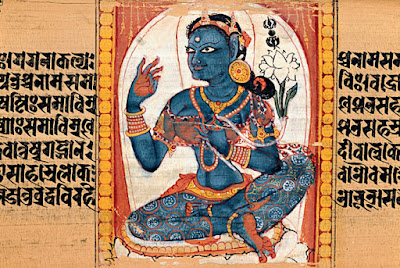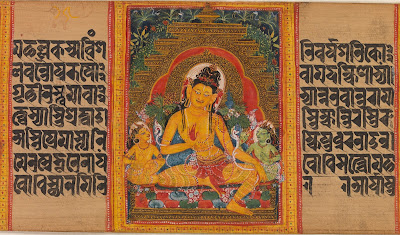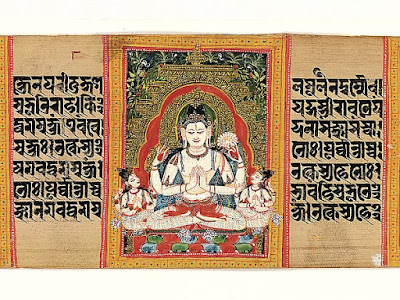 |
| White Tara: Folio from Ashthasahasrika Prajnaparamita Manuscript (Source: Met Museum) |
India has a rich tradition of painting and so does the art of painting on palm leaves or paper. Some historians argue that art of painting on palm leaves or paper can be traced back to the times of Chandragupta Maurya, around 300 BCE, but earlier art could not survive the test of time due to several reasons. And that's why we don't find any trace of painting except great murals before 10th Century.
 |
| Māmakī with a vajra on a lotus: Folio from Aṣṭasāhasrikā Prajñāpāramitā Manuscript |
The earliest examples of palm-leaf or miniature paintings exist in the form of illustration to the Buddhist text executed under Pala rulers of Eastern India (Present day Bengal and Bangladesh). The school derives its name from their Patrons. The period of Mahipala I (988-1036), Nayapala (1038-1053) and Ramapala (1082-1124) can be termed as the golden period of Pala school of art.
 |
| Boddhisattva Maitreya: Folio from Aṣṭasāhasrikā Prajñāpāramitā Manuscript |
The Pala phase of art is also the last great phase of Buddhist art in India. The Buddhist Mahaviharas of Nalanda, Odantapuri, Vikramsila and Somarupa were main centers of learning and art.
 |
| Green Tara: Folio from Aṣṭasāhasrikā Prajñāpāramitā Manuscript |
Thousands of students and learners from all over the world came there for Buddhist learnings, and along with Buddhist learning, they took the Pala art from their and spread it in their respective countries. The glimpse of Pala style can be seen in Tibetan (Vajrayana) school.
 |
| Enthroned Four-armed Bodhisattva, Leaf from a dispersed Pancavimsatisahasrika Prajnaparamita Manuscript (Source: MET Museum) |
A large number of the palm-leaf manuscripts were created during this period. Astasahasrika Prajnaparamita, Pancharaksa, Karandavyuha and Kalachakra Tantra are the prominent piece of Buddhist work of this age.
 |
| Shadakshari Lokesvara: Folio from a manuscript of the Ashtasahasrika Prajnaparamita (Source: Met Museum) |
The Pala miniature painting artists have a distinct style. Unlike their European counterparts, they often use sinuous lines and subdued tones of colours.
 |
| Buddha Enthroned in a Shrine, Leaf from a dispersed Pancavimsatisahasrika Prajnaparamita Manuscript (Source: Met Museum) |
It is a naturalistic style which reflects the idealism of contemporary sculptures and feeling of Ajanta cave paintings.
 |
| Green Tara Dispensing Boons to Ecstatic Devotees: Folio from Ashtasahasrika Prajnaparamita (Source: Met Museum) |
If one look at them carefully, one will often recognize the similarity between them and Ajanta cave paintings, and one might say, they are murals of Ajanta transferred into miniature form.
 |
| Seated Boddhisattva Maitreya: Folio from Ashtasahasrika Prajnaparamita |
The sudden death of Pala art can be attributed to Muslim invasion during the first half of the 13th century. Though, it survived, as mentioned earlier, through monks and artists who fled to Tibet and Nepal.









